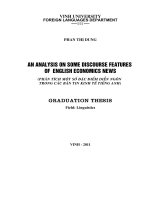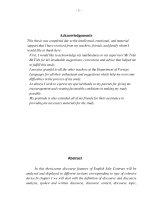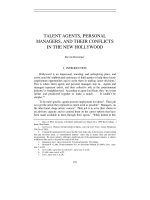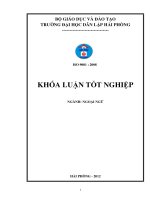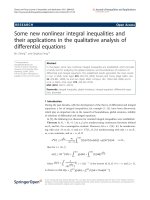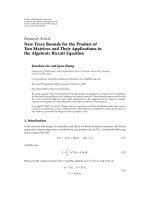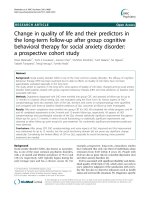some discourse features of requests and their responses in short conversations in the listening comprehension section of toefl materials
Bạn đang xem bản rút gọn của tài liệu. Xem và tải ngay bản đầy đủ của tài liệu tại đây (762.04 KB, 49 trang )
VIETNAM NATIONAL UNIVERSITY, HANOI
UNIVERSITY OF LANGUAGES AND INTERNATIONAL STUDIES
FACULTY OF POSTGRADUATE STUDIES
VÕ VIỆT CƯỜNG
SOME DISCOURSE FEATURES OF REQUESTS
AND THEIR RESPONSES IN SHORT CONVERSATIONS
IN THE LISTENING COMPREHENSION SECTION
OF TOEFL MATERIALS
Một số đặc điểm diễn ngôn của yêu cầu và đáp lại yêu cầu
trong các hội thoại ngắn trong mục nghe hiểu
của tài liệu luyện thi TOEFL
M.A. MINOR THESIS
FIELD: ENGLISH LINGUISTICS
CODE: 60 22 15
HANOI – 2010
VIETNAM NATIONAL UNIVERSITY, HANOI
UNIVERSITY OF LANGUAGES AND INTERNATIONAL STUDIES
FACULTY OF POSTGRADUATE STUDIES
VÕ VIỆT CƯỜNG
SOME DISCOURSE FEATURES OF REQUESTS
AND THEIR RESPONSES IN SHORT CONVERSATIONS
IN THE LISTENING COMPREHENSION SECTION
OF TOEFL MATERIALS
Một số đặc điểm diễn ngôn của yêu cầu và đáp lại yêu cầu
trong các hội thoại ngắn trong mục nghe hiểu
của tài liệu luyện thi TOEFL
M.A. MINOR THESIS
FIELD: ENGLISH LINGUISTICS
CODE: 60 22 15
SUPERVISOR: PHẠM XUÂN THỌ, M.A.
HANOI – 2010
v
TABLE OF CONTENTS
Declaration i
Acknowledgments ii
Abstract iii
Table of contents v
List of tables vii
PART I: INTRODUCTION 1
1. Rationale for the study 1
2. Aims of the study 3
3. Scope of the study 3
4. Methods of the study 4
5. Design of the study 4
PART II: DEVELOPMENT 5
Chapter 1: Theoretical background 5
1.1. Introduction 5
1.2. Systemic Functional Grammar and the clause 5
1.2.1. A brief overview of Systemic Functional Grammar 5
1.2.2. The clause 6
1.3. Above the clause: the clause complex 7
1.3.1. Clause complex and sentence 7
1.3.2. Types of interdependency in clause complexes: parataxis and hypotaxis 8
1.3.3. A brief overview of logico-semantic relations in clause complexes:
expansion and projection 9
1.3.4. Expansion 10
1.3.4.1. Elaboration 10
1.3.4.2. Extension 12
1.3.4.3. Enhancement 13
vi
1.3.4.4. Embedded expansions 14
1.3.4.5. Implicitly marked logical-semantic relations in expansion 15
1.4. Summary 17
Chapter 2: Expansion in the requests and their responses of the short conversations18
2.1. Introduction 18
2.2. Clause complexes in the requests and their responses of the short conversations 19
2.3. Expansion in the requests and their responses of the short conversations 24
2.4. Conjunctions for expansion in the requests and their responses of the short
conversations 32
2.5. Summary 37
PART III: CONCLUSION 38
1. Major findings 38
2. Implications 39
3. Suggestions for further research 40
References 41
Appendix: Twenty selected short conversations I
vii
LIST OF TABLES
Table 1: The rank scale (Thomson, 1996:22) 7
Table 2: Primary and secondary clauses (Halliday, 1994:219) 8
Table 3: Basic types of clause complex (Halliday, 1994:220) 10
Table 4: Inserted conjunctions in the short conversations 22
Table 5: Percentages of paratactic expansion in the short conversations 31
Table 6: Percentages of hypotactic expansion in the short conversations 31
Table 7: Original conjunctions in the short conversations 33
1
PART I: INTRODUCTION
1. Rationale for the study
Besides IELTS (International English Language Testing System), TOEIC (Test of
English for International Communication), and TOEFL iBT (Test of English as a Foreign
Language: Internet-based Test), TOEFL ITP (Test of English as a Foreign Language:
Institutional Testing Program), which is composed of previously administered TOEFL
Paper-based Test forms or TOEFL PBT, has often been used to test the English
competence of learners. A certain acceptable TOEFL ITP score is now one of the
conditions and options which can help professionals get a higher degree or advancement in
their career or both. This is manifested in Circular number 08/2009/TT-BGDĐT from the
Ministry of Education and Training of Vietnam that candidates who have a valid minimum
TOEFL ITP score of 400 or higher do not have to take the English entrance examination
for his M.A. In addition, candidates who have a valid TOEFL ITP score of 450 or higher
are allowed to defend their M.A. dissertation without taking the final exam in English. This
is also manifested in Circular number 10/2009/TT-BGDĐT from the Ministry of Education
and Training of Vietnam that candidates who have a valid minimum TOEFL ITP score of
450 or higher do not have to take the Ph.D. entrance examination for English, and
candidates who have a valid TOEFL ITP score of 500 or higher are allowed to defend their
Ph.D. dissertation without taking the final exam in English. Realizing the importance of
English, the President of Thai Nguyen University issued Decision number 805QĐ/TCCB
stating that from 2008, a TOEFL ITP score is one of the conditions and options used to
decide the job status of the lecturers in all member institutions of the University.
Specifically, only applicants with a minimum TOEFL ITP score of 400 can sign teaching
contracts; only applicants with a minimum TOEFL ITP score of 450 can apply for a
permanent teaching position. A considerable number of other institutions, like Hanoi
University of Education, also require their lecturers to have a valid and acceptable TOEFL
ITP score.
As a teacher of English in Thai Nguyen University, I have had some experience in
instructing quite a large number of students in TOEFL ITP. During the lessons, I have
found that listening seems to be a challenge to my students. One reason is that their
English is not good enough. Our students are graduates, so they probably have the
2
necessary experience and knowledge about the world. However, their knowledge of
English is quite limited because they were not English majors, and the majority of them do
not use English much in their jobs. Thus, they tend to do poorly in the listening
comprehension section of the practice tests in TOEFL PBT materials designed and
introduced by ETS (Educational Testing Service), in which the short conversations
between two people in part A are the first challenge. Besides the high speaking speed of
the native speakers in the recordings and the fact that test takers are allowed to listen to the
recordings only one time without taking notes, the meaning of each conversation conveyed
by the grammatical structures seems to be one of the linguistic components affecting the
students‘ understanding. This means that to comprehend these conversations, the students
have to combine their knowledge of the world and their experience with their knowledge
of English, in which phonetics and semantics are logically structured and conveyed in
grammar to create communication or language in use known as discourse in social
contexts. This also means that grammar is the base supporting meaning in discourse and
discourse analysis. This role of grammar has been recognized by Halliday (1994: xvi):
…. But whatever the final purpose or direction of the analysis, there has to be a grammar
at the base. …. The current preoccupation is with discourse analysis, or ‘text linguistics’;
and it is sometimes assumed that this can be carried on without grammar – or even that it
is somehow an alternative to grammar. But this is an illusion. A discourse analysis that is
not based on grammar is not an analysis at all, but simply a running commentary on a
text: ….
The requests and their responses in the short conversations between two people in
part A of the listening comprehension section of the TOEFL PBT practice tests by ETS
consist of clause complexes formed by clause expansion in Systemic Functional Grammar.
These clause complexes help the speakers in these conversations express their intentions in
a logical way known as the logico-semantic relations among their clauses in Systemic
Functional Grammar. The reason for the analysis of the clause complexes in the requests
and their responses in these conversations also originates from Halliday‘s (1994:224)
viewpoint:
The clause complex is of particular interest in spoken language, because it represents the
dynamic potential of the system – the ability to ‘choreograph’ very long and intricate
patterns of semantic movement while maintaining a continuous flow of discourse that is
3
coherent without being constructional. This kind of flow is very uncharacteristic of written
language.
All the reasons above have encouraged us to conduct an analysis of clause
expansion in the requests and their responses in these short conversations in light of
Systemic Functional Grammar so as to know how it functions to display their typical
discourse features, which can contribute to improving the teaching and learning of the
conversations of this kind.
2. Aims of the study
As stated in the title and the rationale for the study, this study is intended to find out
the typical discourse features of the requests and their responses in the short conversations
in the listening comprehension section of the TOEFL PBT practice tests in light of clause
expansion in Systemic Functional Grammar. To achieve this aim, the study attempts to
answer the following research questions:
1. How does clause expansion function in relation to the other aspects of Systemic
Functional Grammar to display the typical discourse features of the requests and their
responses in the short conversations in the listening comprehension section of the TOEFL
PBT practice tests?
2. Which typical discourse features in light of clause expansion in Systemic
Functional Grammar can be generalized from the analysis of the requests and their
responses in the short conversations in the listening comprehension section of the TOEFL
PBT practice tests?
3. Scope of the study
As stated in the aims of the study, within the framework of an M.A. minor thesis,
we can only focus on the issues concerning clause expansion in Systemic Functional
Grammar in the requests and their responses in the short conversations in the listening
comprehension section of the TOEFL PBT practice tests. These issues are the components
of clause expansion and clause expansion-related aspects of Systemic Functional
Grammar, which are discussed and realized throughout the study. Twenty short
conversations containing requests and their responses were selected from Part A of the
listening comprehension scripts of the book ―TOEFL Preparation Kit Workbook 2002-
2003, Volume 1‖ designed and introduced by ETS. Each of the short conversations
4
consists of two utterances, each of which is made by a man or a woman. Only the clause
complexes in the requests and their responses are analyzed in light of clause expansion in
Systemic Functional Grammar. The twenty short conversations under analysis were
selected according to Quang‘s (2007:151-172) and Nguyen and Vinh‘s (2008:182-184)
suggestions for identifying and using requests and their responses, which will be discussed
in more detail in the introduction of chapter two of the dissertation.
4. Methods of the study
The basic methods applied to this study are descriptive, comparative, and analytical
methods of language research which are generally inductive. Firstly, the issues concerning
clause expansion in Systemic Functional Grammar are extracted, described, compared, and
discussed in chapter one of the thesis to set up the theoretical background underlying the
analysis, discussion, and generalization in chapter two and part three of the dissertation.
Then, the thirty-two clause complexes in the requests and their responses in the twenty
selected short conversations are analyzed in light of clause expansion in Systemic
Functional Grammar. In chapter two and part three of the thesis, the results of the study
will be discussed and generalized based on the statistics to be able to contribute to
improving the teaching and understanding of the conversations of this kind.
5. Design of the study
This dissertation consists of three main parts:
Part one presents the rationale for the study, the aims, scope, methods, and design
of the study.
Part two consists of two chapters. Chapter one discusses clause expansion and its
relevant issues in Systemic Functional Grammar that underlie the analysis of the clause
complexes in the requests and their responses in the short conversations in chapter two.
Chapter two analyzes the clause complexes in the requests and their responses in the short
conversations in light of clause expansion in Systemic Functional Grammar and discusses
their typical discourse features. Each section of this chapter analyzes and discusses one
aspect of expansion in the requests and their responses.
Part three summarizes the major findings of the study, draws out the theoretical and
pedagogical implications of these results, and suggests the directions for further research.
5
PART II: DEVELOPMENT
Chapter 1: THEORETICAL BACKGROUND
1.1. Introduction
This chapter discusses the main issues concerning clause expansion in Systemic
Functional Grammar that underlie the analysis of the clause complexes in the requests and
their responses in the short conversations in chapter two. We will present an overview of
Systemic Functional Grammar in which the clause and clause expansion creating the
clause complexes play a crucial part. Then, the main components and features of the clause
complex and clause expansion will be discussed. Projection, which is not the main issue of
the study, will also be discussed briefly because it also contributes to clause expansion to
create clause complexes.
1.2. Systemic Functional Grammar and the clause
1.2.1. A brief overview of Systemic Functional Grammar
Systemic Functional Grammar is based on the functions of language suggested by
Halliday (1970, 1985, cited in Van (2006a:28-29)). According to him, language performs
three metafunctions which are ideational function, interpersonal function, and textual
function. The ideational function reflects the speaker‘s experience of the real world,
including the inner of his consciousness known as the ―content‖. The ideational function
consists of two subtypes, namely the experiential function and logical function. Language
gives structures to experience and helps determine our way of looking at things and
combining things in a logical way to serve this function. The interpersonal function serves
to establish and maintain social relations among people who play the role of a questioner
or a respondent by asking or answering a question and getting things done. The textual
function provides links with language itself and with the situation in which language is
used. This function enables speakers and writers to create situationally relevant discourses.
This function also enables listeners and readers to distinguish a discourse from a random
set of utterances and sentences.
According to Halliday‘s (1978, 1985, 1994, cited in Van (2005a, 2005b, 2006b),
each of the three metafunctions above is realized through a different system. The ideational
metafunction is realized through the transitivity system or system of process types. There
6
are six types of processes in the transitivity system, namely relational process, verbal
process, mental process, behavioural process, material process, and existential process, all
of which are related to the participants and the circumstances in which they occur. The
interpersonal metafunction is realized through the mood structure. The mood structure
consists of mood and residue. Mood is composed of subject and finite. Residue is
composed of predicator, complement, and adjunct. The textual metafunction is realized
through the thematic structure. The thematic structure consists of theme and rheme. Theme
coincides with the initial component(s) of the clause. Thus, theme is known as the point of
departure of the message of the clause. Rheme is the remainder of the message which
develops theme by adding more information to theme in the clause. The following example
illustrates how these metafunctions are realized through their respective systems in a
clause:
They
grow
vegetables
in the garden
Transitivity
Actor
Process: material
Goal
Circumstance
Mood
Subject
Finite
Predicator
Complement
Adjunct
Mood
Residue
Theme
Theme
Rheme
Clause expansion and projection are the components of the logical function which
gives structures to experience and helps determine our way of looking at things and
combining things in a logical way. The clause complexes formed logically by the clauses
like the example above will be dealt with in the next chapters of the thesis.
1.2.2. The clause
According to Thomson (1996:22), the meaning of a text is composed of its smaller
components, i.e. it‘s sentences, clauses, groups, words, morphemes, which are called
―rank‖ in linguistics. More specifically, a sentence consists of one or more than one clause;
a clause consists of one or more than one group; a group consists of one or more than one
word; a word consists of one or more than one morpheme. Each unit of meaning is
expressed in one rank, which is shown in the following table:
7
Table 1: The rank scale (Thomson, 1996:22)
Sentence ///The little boy shouted when he saw the wolf///
Clause ///The little boy shouted//when he saw the wolf///
Group //[The little boy] [shouted]//
Word [{the}{little}{boy}]
Morpheme {<shout> <ed>}
As can be seen from the table above, the clause plays an important role in
expressing meaning in language in use or discourse. At the clause rank, people can express
how they feel, what they think, how they do things, and how entities exist and happen. It is
this role of the clause that makes it a basic unit in discourse analysis in Systemic
Functional Grammar.
1.3. Above the clause: the clause complex
1.3.1. Clause complex and sentence
In Systemic Functional Grammar, the concept of ―unit complex‖ means that a
larger unit can be interpreted through another ―unit complex‖ smaller in rank. Specifically,
according to (Halliday, 1994:215-216), a verbal group, an adverbial group, and a nominal
group can be interpreted as a word complex in which a Head word is modified by other
words. Similarly, a sentence can be interpreted as a clause complex in which a Head clause
is modified by other clauses. In these two cases, the group evolves by expanding outwards
from the word, and the sentence evolves by expanding outwards from the clause.
Consequently, the expansion causes the word complex to replace the group and the clause
complex to replace the sentence. The expansion appears, reflecting the dynamic potential
of language in use. Therefore, ―the notion of ‗clause complex‘ enables us to account in full
for the functional organization of sentences‖ while the sentence is simply ―the orthographic
unit that is contained between full stops‖. This is the reason why ―a sentence is a
constituent of writing while a clause complex is a constituent of grammar‖ (Halliday:
8
1994:216). This means that clause complex is the grammatical unit above the clause in
Systemic Functional Grammar. Therefore, the term clause complex is the only
grammatical unit above the clause used in the dissertation from now on.
1.3.2. Types of interdependency in clause complexes: parataxis and hypotaxis
This section discusses the interdependency or taxis which is composed of parataxis
and hypotaxis among the clauses in a clause complex. According to Halliday (1994:218),
in a clause complex, the types of interdependency among its clauses depend on their status.
If the status is unequal, the modifying clause is dependent on the modified one. If the status
is equal, they are independent clauses. Hypotaxis is the relation between a dependent
clause and its dominant one on which it is dependent. Parataxis is the relation between two
clauses of equal status in which one initiates and the other continues. Halliday (1994:218)
uses the Greek letter notations: , , … to represent hypotactic structures and the
numerical notations: 1, 2, 3, … to represent paratactic structures in a clause complex, e.g.
I would if I could, but I can‘t.
1
2
Looking at the clause complex above, we can find that the relationship between ―I
would if could‖ and ―but I can‘t‖ is paratactic with 1 and 2 as the notations respectively. In
1: ―I would if I could,‖ the relationship between ―I would‖ and ―if I could‖ is hypotactic
with and as the notations respectively.
Halliday (1994:218) also suggests the term clause nexus formed by primary and
secondary clauses. He explains that the primary is the initiating clause in a paratactic nexus
and the dominant clause in a hypotactic; the secondary is the continuing clause in a
paratactic nexus and the dependent clause in a hypotactic. This is shown in the following
table:
Table 2: Primary and secondary clauses (Halliday, 1994:219)
primary
secondary
parataxis
1 (initiating)
2 (continuing)
hypotaxis
(dominant)
(dependent)
The difference between the numerical notations and the Greek letter notations is
that there is only one ordering presented by the sequence of 1, 2, 3, … in paratactic
9
relations while there are various orderings between at least two clauses in hypotactic
relations, which are shown as follows in Halliday (1994:222-223):
(i) The dependent clause follows the dominant one, e.g.
You never can tell till you try. ()
(ii) The dependent clause precedes the dominant one, e.g.
If wishes were horses, beggars would ride. ()
(iii) The dependent clause is enclosed in the dominant one, e.g.
Picture, if you can, a winkle. (<<>>)
(iv) The dependent clause encloses the dominant one, e.g.
He might, he said, finish it himself. (<<>>)
1.3.3. A brief overview of logico-semantic relations in clause complexes: expansion
and projection
Before discussing expansion in more detail, we would like to present a brief
overview of the logico-semantic relations among the clauses in a clause complex. Besides
the interdependency among the clauses in a clause complex, Halliday (1994:219-220) also
introduces the logico-semantic relations among them which are expansion and projection.
Projection is not the main issue of the study; it still contributes to the expansion of the
clauses in a clause complex, however. According to Halliday (1994:219), expansion may
be defined as a case in which the secondary clause expands the primary clause by
elaborating it, extending it, or enhancing it. One clause expands another by elaborating on
it (or some portion of it): restating in other words, specifying in greater detail,
commenting, or exemplifying to give us the notion of elaboration. One clause expands
another by extending beyond it: adding some new element, giving an exception to it, or
offering an alternative to give us the notion of extension. One clause expands another by
embellishing around it: qualifying it with some circumstantial feature of time, place, cause
or condition to give us the notion of enhancement. Projection may be defined as a case in
which the secondary clause is projected through the primary clause, which instates it as a
locution or an idea. In projection of locution, one clause is projected through another,
which presents it as a locution, a construction of wording. In projection of idea, one clause
is projected through another, which presents it as an idea, a construction of meaning.
10
Halliday (1994:219) uses (=) for elaboration, (+) for extension, and (x) for enhancement in
expansion. He uses (―) for projection of locution and (‗) for projection of idea. The
examples in the following table illustrate Halliday‘s (1994:219-220) descriptions above:
Table 3: Basic types of clause complex (Halliday, 1994:220)
(i) paratactic
(ii) hypotactic
(1) Expansion
(a)
elaboration
John didn‘t wait;
1
he ran away.
= 2
John ran away,
which surprised everyone.
=
(b)
extension
John ran away,
1
and Fred stayed behind.
+ 2
John ran away,
whereas Fred stayed behind.
+
(c)
enhancement
John was scared,
1
so he ran away.
x 2
John ran away,
because he was scared.
x
(2) Projection
(a)
locution
John said:
1
‗I‘m running away‘
―2
John said
he was running away.
―
(b)
idea
John thought to himself:
1
‗I‘ll run away‘
‗2
John thought
he would run away
‗
According to Halliday (1994:225), elaborating, extending, and enhancing in
expansion can be compared with three ways of enriching a building in which we can
elaborate its existing structure, extend it by addition or replacement, and enhance its
environment. Following is the discussion about expansion – the subject matter under study,
which is composed of elaboration, extension, enhancement, embedded expansions, and
implicitly marked logical semantic relations in expansion.
1.3.4. Expansion
1.3.4.1. Elaboration
Halliday (1994:225) describes elaboration as follows:
In elaboration, one clause elaborates on the meaning of another by further specifying or
describing it. The secondary clause does not introduce a new clement into the picture but
rather provides a further characterization of one that is already there, restating it, clarifying
11
it, refining it, or adding a descriptive attribute or comment. The thing that is elaborated
may be the primary clause as a whole, or it may be just some part of it – one or more of its
constituents.
In parataxis, elaboration is categorized as three types which Halliday (1994:226)
calls exposition, exemplification, and clarification.
He explains that in exposition the secondary clause restates the thesis of the
primary clause in different words, to present it from another point of view, or perhaps just
to reinforce the message. For example:
That clock doesn‘t go; it‘s not working.
She wasn‘t a show dog; I didn‘t buy her as a show dog.
Each argument was fatal to the other: both could not be true.
(Halliday, 1994:226)
The logical-semantic relation in exposition can be expressed explicitly by ―or
(rather)‖, ―in other words‖, ―that is to say‖, or ―i.e.‖ in writing.
He also explains that in exemplification the secondary clause develops the thesis of
the primary clause by becoming more specific about it, often citing an actual example. For
instance:
We used to have races – we used to have relays.
Your face is the same as everybody else has – the two eyes so, nose in the middle, mouth
under.
(Halliday, 1994:226)
The logical-semantic relation in exemplification can be expressed explicitly by ―for
example‖, ―for instance‖, ―in particular‖, or ―e.g.‖ in writing.
He describes clarification as a case in which the secondary clause clarifies the
thesis of the primary clause, backing it up with some form of explanation or explanatory
comment. For example:
Alice could only look puzzled: she was thinking of the pudding.
They weren‘t show animals; we just had them as pets.
He never said anything to her; in fact his last remark was evidently addressed to a tree.
I wasn‘t surprised – it was what I had expected.
12
(Halliday, 1994:226)
The logical-semantic relation in clarification can be expressed explicitly by ―in
fact‖, ―actually‖, ―indeed‖, ―at least‖, or ―i.e.‖, or sometimes ―viz.‖ in writing.
In hypotactic elaboration, Halliday (1994:226-229) explains that the primary clause
is elaborated by non-defining relative clauses. According to him, both finite and non-finite
classes of this kind can function as elaboration. For example:
They decided to cancel the show, which upset everybody alike.
Inflation, which was necessary for the system, became also lethal.
Have you been to Wensleydale, where the cheese comes from?
I worked for a local firm at that time, selling office equipment.
It‘s my own invention – to keep clothes and sandwiches in.
(Halliday, 1994:227-229)
1.3.4.2. Extension
Halliday (1994:230) states that the meaning of one clause can be extended by
another clause. This can be just an addition, a replacement or an alternative. According to
him, in parataxis, extension is composed of addition, variation, and alternation. In addition
relation, ―one process is simply adjoined to another; there is no implication of any causal
or temporal relationship between them‖. In variation relation, ―one clause is presented as
being in total or partial replacement of another‖. In alternation relation, ―one clause is
offered as alternative to another‖. Extension relation is typically expressed by ―and‖,
―nor‖, ―or‖, ―but‖, ―instead‖, ―except‖, in which addition is typically expressed by ―and‖,
―nor‖, ―but‖, variation is typically expressed by ―instead‖, ―except‖, and alternation is
typically expressed by ―or‖. These are illustrated in the following examples cited from
Halliday (1994:230-231):
I breed the poultry, and my husband looks after the garden.
They don‘t give any instructions, nor would it help if they did.
Either you go ahead and take the plunge or you wait till you think you can afford it, which
you never will.
Don‘t stand there chattering to yourself like that, but tell me your name and your business.
13
In terms of hypotaxis, Halliday (1994:231) categorizes extension as addition,
variation (replacement and subtraction), and alternation, but only the dependent clause
which is finite or non-finite extends.
In the finite form, hypotactic addition can be typically expressed by the
conjunctions ―whereas‖ and ―while‖; hypotactic subtraction in addition relation can be
typically expressed by ―except that‖, ―but (for the fact) that‖; hypotactic alternation can be
typically expressed by ―if … not‖ (―if not a, then b‖). There is no hypotactic replacement
in the finite form, however. These are illustrated in the following examples cited from
Halliday (1994:231):
The executioner, the King and the Queen were all talking at once, while all the rest were
quite silent.
If you haven‘t lost it, then it‘s in that cupboard.
He kept on pretty well, except that he had a habit of now and then falling off side ways.
In the non-finite form, Halliday (1994:231-232) also suggests imperfective clauses
in hypotactic extension, which are introduced by a preposition or preposition group
functioning as a conjunctive like ―besides‖, ―apart from‖, ―instead of‖, ―other than‖,
―without‖. These are illustrated in the following examples cited from Halliday (1994:231-
232):
We used to go away at the weekend, taking all our gear with us.
You won‘t get rid of it, other than giving it away.
1.3.4.3. Enhancement
Halliday (1994:232) states that one clause can enhance the meaning of another by
referring to the time, place, manner, cause or condition. According to him, enhancement
also consists of parataxis and hypotaxis. In hypotactic enhancement, both finite and non-
finite clauses can combine with their dominant one. The following examples cited from
Halliday (1994:234-238) illustrate these:
* Finite:
(i) Temporal:
It‘s the Cheshire Cat: now I shall have somebody to talk to.
14
(ii) Spatial:
Alice looked up, and there stood the Queen in front of them.
(iii) Manner:
She likes the simple life, and so does he.
(iv) Causal-conditional:
Alice didn‘t want to begin another argument, so she said nothing.
I like to follow up one line at a time, otherwise there‘s a muddle.
* Non-finite:
They must be crazy, throwing all that good stuff away.
To claim your rebate simply fill in the voucher and post it to us.
Turn off the lights before leaving.
1.3.4.4. Embedded expansions
Halliday (1994:242) defines embedding as a mechanism whereby a clause or
phrase comes to function as a constituent within the structure of a group, which itself is a
constituent of a clause.
He also uses the notation ―[[ ]]‖ to contain each of the embedded clauses in a
clause complex. According to him, embedded clauses can elaborate, extend, and enhance
their preceding group which itself is a constituent of a clause. Embedded elaboration is
composed of finite or non-finite relative clauses which can function as Postmodifier
clauses or Head clauses introduced by ―who‖, ―which‖, ―that‖. Embedded extension is
composed of possessive relative clauses introduced by ―whose‖, ―of which‖. Embedded
enhancement is composed of time, place, manner, cause or condition circumstances
introduced by their respective clauses. The following examples cited from Halliday
(1994:243-248) illustrate these:
* Finite:
The man [[who came to dinner]] stayed for a month.
She couldn‘t find anyone [[she could give the message to]].
The reason [[why I like her]] is she doesn‘t have favourites.
* Non-finite:
Alice was too much puzzled [[to say anything]].
15
[[Threatening people]] will get you nowhere.
I heard [[the water lapping on the crag]].
1.3.4.5. Implicitly marked logical-semantic relations in expansion
In many cases, the identification of the logical-semantic relations in expansion does
not depend only on the explicit use of their markers. Halliday (1994:239) states that in both
spoken and written English, we find unconjoined sequences which seem to be functioning
as clause complexes, yet which do not seem to be restricted to the elaborating type. This
arises in the analysis of both finite and non-finite clauses. In the case of finite clauses,
Halliday (1994:239) introduces an example from spontaneous speech in which the clauses
are related by expansion marked off by commas:
At the last meeting somebody almost got drowned, he was practising rescuing somebody,
no-one had really shown how to do it, he had to be dragged out by some of the older lads,
nobody really thought it was that bad, they just thought he‘d got cramp or something.
Halliday suggests two ways to approach this problem. Firstly, he suggests that we
can insert a conjunction without changing the logical-semantic relation wherever we can
recognize a relation of expansion. Thus, without paying attention to projections, the
example above can be reworded and analyzed as follows:
///At the last meeting somebody almost got drowned;//he was practising rescuing
1 = 2
somebody,//‗but‘ no-one had really shown how to do it,//‗so‘ he had to be dragged
+ 3α 3‘β
out by some of the older lads.///Nobody really thought it was that bad;//they just
x 4 1α 1‘β
thought he‘d got cramp or something.///
= 2α 2‘β
(Halliday, 1994:239)
16
Secondly, he suggests that we do not need to reword the example text by inserting
the conjunctions as above. Thus, the text can be analyzed as follows:
///At the last meeting somebody almost got drowned;//he was practising rescuing
1 = 2
somebody,//No-one had really shown how to do it,//He had to be dragged
1 1‘β
out by some of the older lads.///Nobody really thought it was that bad;//they just
1α 1‘β
thought he‘d got cramp or something.///
= 2α 2‘β
(Halliday, 1994:240)
For non-finite clauses, Halliday suggests that we can depend on the contexts to
define the types of expansion. Accordingly, if the nearest finite form is a non-defining
relative clause, then the non-finite is elaborating; if it is a co-ordinate clause, the non-finite
is extending; if it is an enhancing clause, the non-finite is enhancing and it can probably be
introduced by a conjunctive preposition. The following examples cited from Halliday
(1994:240) illustrate these:
He left the house, closing the door behind him.
and closes the door … [extending]
I worked for a local firm, selling office equipment.
; I sold … (‗I was doing some work, which was …‘)
[elaborating]
Not wanting to offend, Mary kept quiet.
Because she did not want … [enhancing]
Having said goodbye, John went home.
After he had said … [enhancing]
Some precipitation is expected, falling as snow over high ground.
which will fall … [elaborating]
17
The Sonora road was opened by Mexican explorers, supplanting the Anza trail.
and supplanted …
[extending]
1.4. Summary
In this chapter, the essential theory underlying the subject matter under analysis has
been presented. The main issues concerning Systemic Functional Grammar and the clause
have also been discussed. The three metafunctions of language and their realizations
through the three respective systems have been introduced in which the clause is the basic
grammatical unit to express them in Systemic Functional Grammar. A discussion of the
clause complex – the grammatical unit above the clause in Systemic Functional Grammar
has also been included in this chapter. A distinction between the clause complex and the
sentence has been made. Then, the terms parataxis, hypotaxis, expansion, and projection
have been explained, followed by a detail discussion of expansion and its components. All
the discussed issues in this chapter underlie the analysis in chapter two and the conclusion
in part three of the thesis.
18
Chapter 2: EXPANSION IN THE REQUESTS AND THEIR
RESPONSES OF THE CONVERSATIONS
2.1. Introduction
This chapter presents the analysis of the clause complexes in the requests and their
responses in 20 short conversations in terms of clause expansion in Systemic Functional
Grammar. The twenty short conversations were selected from part A of the listening
comprehension scripts of the book ―TOEFL Preparation Kit Workbook 2002-2003,
Volume 1‖ designed and introduced by ETS, which consists of seven practice tests. The
practice tests are similar to the real ones in format. Part A is the first part in section one –
listening comprehension of the tests. There are thirty short conversations in part A, each of
which consists of two utterances made by a man or a woman. After listening to each
conversation and its question, test takers have to choose the best answer from the four
options given in the question paper. In the description of section one of the tests, ETS
(2004:18A) introduces:
The topics of the conversations are relevant to student life on campus, such as returning a
book to the library, asking about a homework assignment, or taking a bus to class.
The people in the conversations have many different purposes for speaking to each other.
For example, in one conversation someone may be apologizing, in another someone might
be giving advice, and in another someone might be asking for information.
The twenty short conversations under analysis are selected according to Quang‘s
(2007:151-172) and Nguyen and Vinh‘s (2008:182-184) suggestions for identifying and
using requests and their responses. The selection of the conversations was also request-
based in that the following discourse markers for the requests in Quang‘s (2007:151-157)
and Nguyen and Vinh‘s (2008:182)‘s suggestions are the criteria: ―Can/could you ?‖,
―Will you ?‖, ―Do you think you could …?‖, ―I/we would/‘d like …‖, ―I need …‖,
―Come on! …‖, ―Let‘s …‖, ―I‘m looking for …‖, ―I‘m calling to see …‖. In the following
section, these twenty short conversations will be analyzed and discussed in terms of clause
complex analysis, clause expansion analysis, and conjunction analysis respectively.
19
2.2. Clause complexes in the requests and their responses of the short conversations
In order to analyze the clause complexes in the requests and their responses
effectively, we number the conversations from one to twenty, each of which consists of
two utterances. The first one is the request, and the second one is the response. We also use
the notation ―///‖ for the clause complex boundaries and the notation ―//‖ for the clause
boundaries in the requests and their responses of the conversations. The clause simplexes
in the conversations do not have any notations. The conjunctions in bold type were inserted
according to Halliday‘s (1994:239) suggestion that we can insert a conjunction without
changing the logical-semantic relation wherever we can recognize a relation of expansion.
The embedded clause expansions are put into the notation ―[[ ]]‖. Each of the clause
complexes is numbered in brackets at the end of it. Following is the analysis of the
requests and their responses in the short conversations in terms of clause complexes:
Conversation 1:
(woman) I‘m looking for a lightweight jacket … navy blue … medium …
(man) ///Let‘s see.//So have you checked the sales rack in the back?//In fact, there
were still a few there yesterday.///(1)
Conversation 2:
(man) Can you come over for dinner tonight?
(woman) ///I‘m up to my ears in work,//so I‘ll have to take a rain check.///(2)
Conversation 3:
(man) Hello? I‘d like two seats for this evening‘s show.
(woman) ///Sorry, but the performance is already sold out.//So would you be
interested in something later this week?///(3)
Conversation 4:
(man) My wife and I would like to have you over for dinner on Friday.
(woman) ///That‘s very kind of you,//but I have theater tickets for that evening.///(4)
Conversation 5:
(man) I‘d like you to come with me to the opening of the photography exhibit.
(woman) ///I‘m exhausted!//So you‘ll have to manage without me tonight.///(5)
20
Conversation 6:
(man) ///I need to talk to someone//[[who knows a lot about Portland]].//In fact,
someone said//you lived there.///(6)
(woman) Oh, but I was really young at the time.
Conversation 7:
(woman) ///Could you please tell me//where to find running shoes?///(7)
(man) Yes, they‘d be on the second floor in sporting goods.
Conversation 8:
(man) ///I‘d like to borrow that book//after you‘ve finished it.///(8)
(woman) Sure, but I‘ve promised it to Jane first.
Conversation 9:
(woman) ///Could you bring my calculator back —//In fact, I need it//to do my math
homework tonight.///(9)
(man) ///I don‘t know//how to put this —//but, uh, I dropped it,//and now the ―on‖
button doesn‘t light up.///(10)
Conversation 10:
(woman) ///Can you come to the concert with me this weekend,//or do you have to
prepare for exams?///(11)
(man) ///I still have a lot//to do … //but maybe a break would do me good.///(12)
Conversation 11:
(man) ///Hello, this is Mark Smith.//And I‘m calling to see//if my blood test results
are in.///(13)
(woman) ///Dr. Miller just sent them to the lab last night,//so the earliest [[they could
be back]] is tomorrow.///(14)
Conversation 12:
(woman) ///Come on,//in fact, we‘re almost there.//And I‘ll race you to the top of the
hill.///(15)
(man) ///I‘m so out of shape;//so I might have to crawl the rest of the way.///(16)

